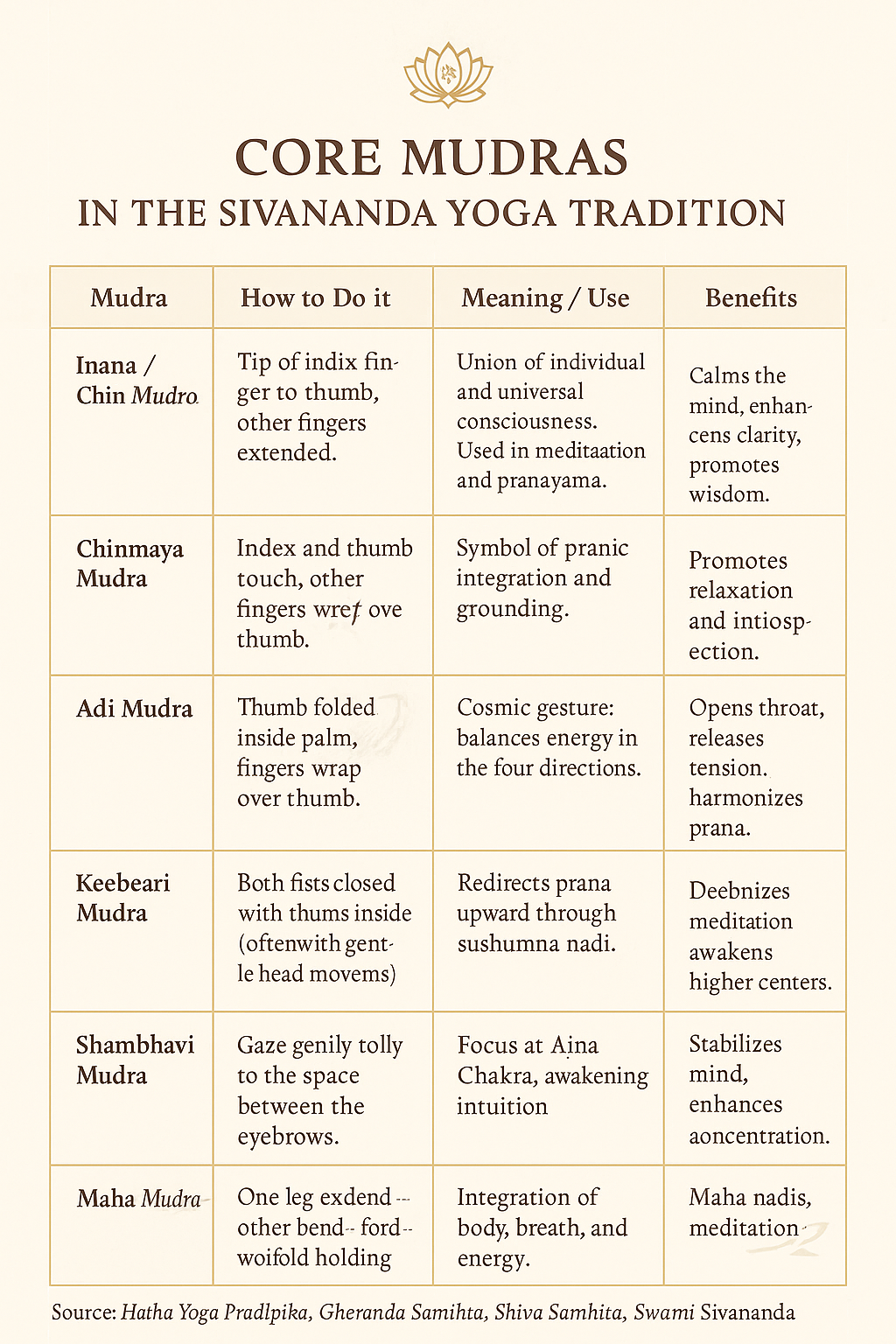
200 hrs Yoga TTC
Module 1
Techniques, Training & Practice (80 Hours)
Meditation, Chanting, Mantra,Kirtan & Mudra (10 Hours)
This section explores meditation techniques, the use of mantras and chanting, and mudras for energy channeling.
• Meditation: Mindfulness, body scan, metta (loving-kindness), compassion.
• Chanting: Sanskrit mantras, kirtan for focus and devotion.
• Mudras: Vishnu Mudra, Chin Mudra, Anjali Mudra.
• Benefits: Promotes clarity, emotional balance, spiritual connection.
Meditations
Body Scan Meditation — Grounding in Presence
Core intention: Cultivate embodied awareness and relaxation.
Practice (formal):
Set aside 10–20 minutes daily.
Lie down or sit comfortably.
Bring attention slowly from head to toe (or vice versa), sensing each part of the body.
Notice sensations—tingling, tension, warmth—without judgment.
When the mind wanders, gently return to the felt sense of the body.
Daily integration:
Take one mindful minute before meals or after waking to feel your feet on the ground and sense the breath moving through the body.
During the day, silently ask: “Where is my body right now?” and soften into presence.
2. Taking in the Good — Cultivating Inner Resourcefulness
Core intention: Strengthen positive neural patterns and self-trust through savoring goodness.
Practice (formal):
Once or twice a day, recall or notice something pleasant: a smile, sunlight, a kind word.
Pause for 15–30 seconds to really feel it in the body.
Let the warmth, gratitude, or joy sink in—imagine it permeating you.
You can place a hand on your heart as you do this to anchor the experience.
Daily integration:
Each night, reflect on 3 small good moments from the day.
When something nourishing happens, pause before moving on—let it register fully rather than rushing past.
3. Loving Awareness (Loving-Kindness / Compassion Meditation)
Core intention: Open the heart with kindness toward self and others.
Practice (formal):
Sit quietly for 10–15 minutes.
Bring gentle attention to the heart.
Silently repeat phrases such as:
May I be safe. May I be kind to myself. May I live with ease.
Then extend to others: May you be happy. May you be peaceful. May you be free.If emotions arise, let them move through with tenderness.
Daily integration:
When you notice self-criticism, pause and say inwardly: “This is a moment of suffering. May I be kind to myself.”
Before sleep or while walking, send silent blessings to people you encounter.
Traditional japa meditation:
What is Japa Meditation
Japa means repetition—it’s the continuous repetition of a sacred sound, word, or mantra.
In the Sivananda Yoga tradition, Japa is one of the most direct ways to steady the mind and awaken spiritual awareness. Swami Sivananda taught that "Japa is the easiest, safest and surest way to God-realization in this Kali Yuga (the present age)."
He emphasized that each repetition of a mantra is like sowing a seed of divine vibration in the mind. Over time, these seeds grow into inner peace, clarity, and devotion.
How to Practice Japa Meditation
1. Choose a Mantra
Select a mantra that feels uplifting and universal (see below).
In the Sivananda lineage, mantras are traditionally received from a teacher, but anyone can begin with a simple, sacred name of the Divine.
2. Settle Yourself
Sit comfortably with the spine upright. Close your eyes and take a few deep breaths to center yourself.
3. Use a Mala (optional)
Traditionally, a mala of 108 beads is used. One bead is moved with each repetition, helping you stay focused and consistent.
Hold the mala in the right hand, between the middle finger and thumb. The index finger does not touch the beads—it represents the ego, which stays separate from the practice.
Repeat the Mantra
Softly repeat the mantra aloud or mentally.
Aloud (Vaikhari Japa): For beginners; helps anchor attention.
Whispered (Upamsu Japa): Quietly, barely audible.
Mental (Manasika Japa): Silent repetition in the mind; most powerful as concentration deepens.
5. Focus on Meaning and Feeling
Let the sound, rhythm, and vibration draw you inward. Feel the mantra as a living presence, not just words.
6. Conclude Gently
After completing your rounds, sit quietly for a few moments. Feel the stillness and the subtle energy the mantra has awakened.
Accessible Mantra for Everyone
Mantra:
“Om Namah Shivaya”
Pronounced: Om Na-mah Shi-va-ya
Meaning: “I bow to Shiva,”—not as a deity outside, but as the inner Self, the pure consciousness in all beings.
This mantra is both simple and universal—it’s about honoring the divine essence within and around you.
Swami Sivananda described it as a panacea for all ills of the mind, bringing strength, peace, and balance.
Chanting, Mantra & Kirtan
The Value of Bhakti in the Path of Yoga (According to Swami Sivananda)
Swami Sivananda regarded Bhakti Yoga — the path of love and devotion — as the most natural, sweet, and powerful way to reach the Divine. He taught that while knowledge (Jnana), meditation (Raja Yoga), and selfless service (Karma Yoga) purify and refine the intellect and mind, it is Bhakti that opens the heart and fills the entire being with divine grace.
For Swami Sivananda, true yoga is union with God, and Bhakti is the force that makes this union effortless. Devotion melts the ego, softens the intellect, and transforms personal emotion into divine love. He often said:
“Love is the greatest purifier. Where love is, there God is. Where the heart melts in devotion, all yoga becomes spontaneous.”
In his training of yoga teachers, Sivananda emphasized Bhakti to balance the discipline of asana, the rigor of study, and the silence of meditation. Chanting, kirtan, and prayer awaken shraddha (faith) and ananda (joy), infusing practice with inspiration rather than austerity.
He taught that Bhakti is not separate from Jnana or Karma, but their culmination — for in surrendering to the Divine, one transcends the sense of “I” and “mine,” realizing the same divine presence in all beings. As the Bhagavad Gita (18.66) declares, “Abandon all duties and take refuge in Me alone.”
Thus, Sivananda wove Bhakti through every aspect of the Sivananda Yoga path — through chanting, prayer, arati, and service — so that the student’s practice would not only discipline the body and calm the mind, but also awaken the heart to unconditional love, humility, and divine remembrance.
🕉️ 1. Dhyāna Ślokas (Meditation Verses)
These are chanted at the beginning of every Sivananda class or satsang.
🌿 a. Guru Stotram
(Invocation to the Guru as the embodiment of the Supreme)
Sanskrit (IAST Transliteration):
Brahmānandam Paramasukhadam Kevalam Jñānamūrtim
Dvandvātītam Gagana-sadṛśam Tattvamasyādi-lakṣyam ।
Ekam Nityam Vimalam Acalam Sarvadhī-sākṣibhūtam
Bhāvātītam Triguṇa-rahitam Sadguruṁ Tam Namāmi ॥
Translation:
I bow to the Sadguru who is bliss of Brahman, giver of supreme happiness, embodiment of pure knowledge, beyond pairs of opposites, like the infinite sky, the goal of “Tat Tvam Asi.”
The one eternal, pure, immovable, witness of all intellects, beyond thought and beyond the three gunas.
Pronunciation Guide:
Brahmānandam → brah-MAA-nan-dum
Paramasukhadam → puh-ruh-muh-su-kha-dum
Jñānamūrtim → gnyah-nuh-moor-tim
Namāmi → nuh-MAA-mee (soft “nuh”, long “aa”)
🌿 b. Gajānanaṁ Bhūta Gaṇādi Sevitam
(Invocation to Lord Ganesha – remover of obstacles)
Sanskrit:
Gajānanaṁ Bhūta Gaṇādi Sevitam
Kapittha Jambū Phala Cāru Bhakṣaṇam ।
Uma-sutam Śoka Vināśa Kāraṇam
Namāmi Vighneśvara Pāda Paṅkajam ॥
Translation:
Salutations to Ganesha, who is served by the celestial beings, who eats sweet fruits like kapittha and jambu, the beloved son of Uma, the remover of sorrow, I bow to His lotus feet.
Pronunciation:
Gajānanaṁ → guh-JAA-nuh-num
Bhūta Gaṇādi → BHOO-tuh guh-NAA-dee
Vighneśvara → vig-NAY-shuh-ruh
Paṅkajam → PUN-kuh-jum
🌿 c. Saraswati Namastubhyam
(Invocation to Goddess Saraswati, patroness of learning and speech)
Sanskrit:
Saraswati Namastubhyam Varade Kāmarūpiṇi ।
Vidyārambhaṁ Kariṣyāmi Siddhir Bhavatu Me Sadā ॥
Translation:
Salutations to you, Saraswati, giver of boons and fulfiller of wishes. I begin my studies with you; may success be mine always.
Pronunciation:
Saraswati → suh-ruh-swah-tee
Namastubhyam → nuh-muhs-toob-hyum
Vidyārambhaṁ → vid-yah-RUM-bhum
Bhavatu Me Sadā → bhuh-vuh-too may suh-DAA
🌿 d. Om Namah Shivaya Gurave
(Salutation to the Guru as embodiment of Shiva)
Sanskrit:
Om Namah Shivaya Gurave
Saccidānanda Mūrtaye ।
Niṣprapañcāya Śāntāya
Śrī Śivānandāya Te Namah ॥
Translation:
I bow to the Guru who is Shiva, whose form is Existence, Consciousness, and Bliss, who is beyond the world and serene. Salutations to that Guru, Swami Sivananda.
Pronunciation:
Saccidānanda → sut-chee-DAA-nun-duh
Niṣprapañcāya → nish-prah-pun-CHAA-yuh
Śāntāya → SHAAN-taa-yuh
🕉️ 2. Mahā Mrityunjaya Mantra
(The great victory over death mantra – to Lord Shiva)
Sanskrit:
Om Tryambakaṁ Yajāmahe
Sugandhiṁ Puṣṭi-vardhanam ।
Urvārukamiva Bandhanān
Mṛtyor Mukṣīya Mā’mṛtāt ॥
Translation:
We worship the three-eyed Lord (Shiva), fragrant and nurturing all beings. May He liberate us from the bondage of death, like a cucumber is released from the vine, but not from immortality.
Pronunciation:
Tryambakam → try-um-buh-kum (try as in “tri”)
Yajāmahe → yuh-JAA-muh-hay
Urvārukamiva → oor-vah-roo-kum-ee-vuh
Mṛtyor Mukṣīya → mrit-yor mook-SHEE-yuh
🕉️ 3. Gayatri Mantra
Sanskrit:
Om Bhūr Bhuvaḥ Svaḥ
Tat Savitur Vareṇyam ।
Bhargo Devasya Dhīmahi
Dhiyo Yo Naḥ Prachodayāt ॥
Translation:
We meditate upon the divine light of the radiant sun (the Supreme Consciousness). May that light illuminate our intellects and guide us on the path of truth.
Pronunciation:
Bhūr Bhuvaḥ Svaḥ → bhoor bhu-vuh swuh
Savitur Vareṇyam → suh-vee-toor vuh-RAIN-yum
Prachodayāt → pruh-cho-dah-YAAT
🕉️ 4. Om Namah Shivaya
(Panchakshari Mantra – “five-syllabled mantra” of Shiva)
Sanskrit:
Om Namah Shivāya ॥
Translation:
I bow to Shiva — the auspicious one, the inner Self of all.
Pronunciation:
Namah → nuh-MAH
Shivāya → shi-VAA-yuh
(soft “shi,” not “see”; long “aa”)
🕉️ 5. Hari Om / Kirtans (examples)
Govinda Jaya Jaya
Govinda Jaya Jaya
Gopāla Jaya Jaya
Radha-Ramana Hari
Govinda Jaya Jaya ॥
Meaning:
Victory to Govinda (Krishna), to Gopala the protector of cows, to Hari, the beloved of Radha.
(Devotional chant invoking joy and love.)
Pronunciation tips:
Govinda → go-VEEN-dah
Jaya → JAI-yuh
Radha → RAA-dhaa (long “aa”)
Hari → HUH-ree
🕉️ 6. Jaya Jaya Arati (Sivananda’s composition)
Opening lines:
Jaya Jaya Arati Vighnavināyaka
Vighnavināyaka Śrī Ganesha ।
Jaya Jaya Arati Subrahmaṇya
Subrahmaṇya Karttikeya ।।
…and continues invoking Shiva, Vishnu, Devi, Ganga, Guru, etc.
Meaning:
Victory to the Divine — to Ganesha, Subrahmanya, Shiva, Vishnu, Mother Saraswati, and to the Guru.
(It symbolizes offering the light of our consciousness to the Divine in all forms.)
Pronunciation tips:
Arati → AA-ruh-tee
Vighnavināyaka → vig-nuh-vee-NAA-yuh-kuh
Subrahmaṇya → soo-brah-MUN-yuh
🕉️ Closing Peace Chant
Always ends the session:
Sanskrit:
Om Shāntiḥ Shāntiḥ Shāntiḥ ॥
Meaning:
Peace — in the body, mind, and spirit.
Peace — in the individual, the society, and the universe.
Pronunciation:
Shāntiḥ → SHAAN-teeh (long “aa,” final “h” softly aspirated)
🌸 Notes on Chanting Practice
Pitch & Tone: Natural, medium tone — not forced. Focus on resonance in the heart or chest.
Speed: Moderate, rhythmic, with full breath support.
Repetition: 3x, 9x, or 108x (for japa).
Focus: Keep awareness at the heart center or third eye.
Pronunciation tip: Long vowels (ā, ī, ū) should be held twice as long as short vowels (a, i, u). This preserves the mantra’s vibration.
Mudras in the Sivananda Tradition
“Mudra is the key to stillness; the body becomes the seal through which divine energy flows.” – Swami Sivananda
🌿 What Are Mudras?
Mudras are sacred gestures or seals that channel prana (vital energy) within the body.
Used in asana, pranayama, and meditation, they steady the mind, harmonize the nervous system, and awaken higher awareness.
Their practice is described in the Hatha Yoga Pradipika, Gheranda Samhita, and Shiva Samhita.
-
This section introduces foundational yoga postures, their method of practice, benefits, contraindications, and modifications. Each asana is studied in detail with teaching methodology and alignment principles.
-
-
-


